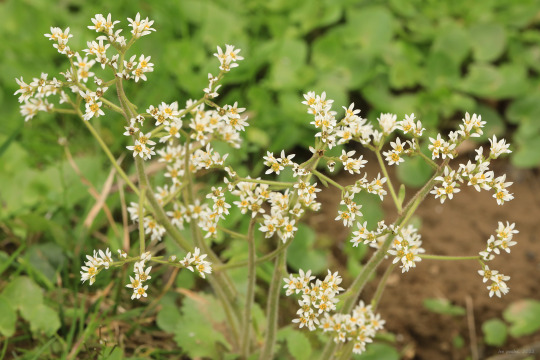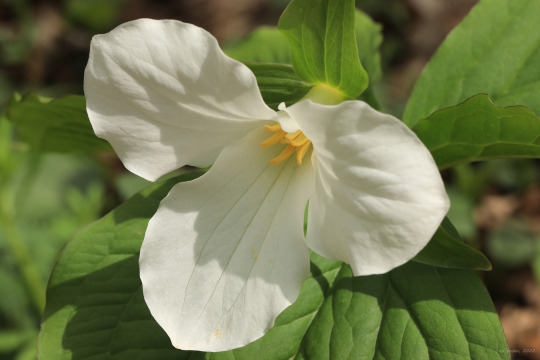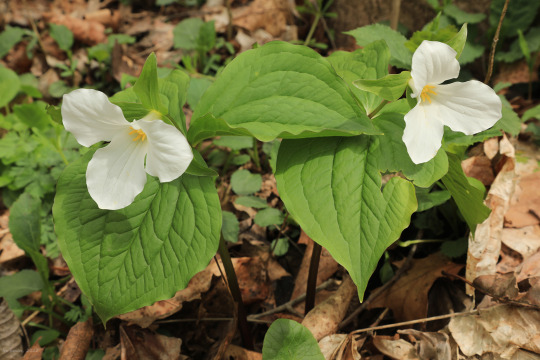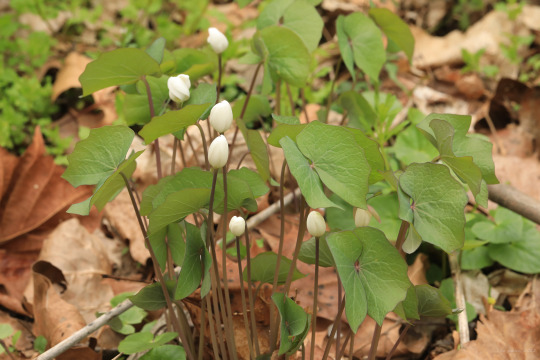#ranunculus septentrionalis
Explore tagged Tumblr posts
Photo










In honor of fishdetective, yet another barrage of tiny flower close-ups - courtesy of the riparian habitat along Dunkard Creek.
From top: early saxifrage (Micranthes virginiensis); azure bluet (Houstonia caerulea), also known as Quaker ladies; Dutchman’s breeches (Dicentra cucullaria); great white trillium (Trillium grandiflorum); swamp buttercup (Ranunculus septentrionalis); twinleaf (Jeffersonia diphylla); and sessile trillium (Trillium sessile), also known as toadshade and toad trillium.
Field Notes:
1. Early saxifrage is most at home in the moist cracks and crevices of rock outcroppings, but occasionally takes to streambanks. All the saxifrages are quite beautiful and many are edible, although somewhat bitter-tasting.
2. Although botanists dispute whether or not swamp buttercup is a distinct species from hispid buttercup (Ranunculus hispidus), both plants are capable of producing striking pops of yellow color along seeps and springs from mid-spring to early summer. Our native buttercups can be distinguished from the infamously-invasive creeping buttercup (Ranunculus repens) by their upward growth habit, more deeply-cleft leaves, and lack of white blotches on the leaves.
3. Easily identified by its twin-lobed leaves resembling angel wings, twinleaf is one of Appalachia’s most unusual wildflowers. The plant’s fragile, white flowers have a very short bloom period (less than a week), in part because the petals are easily blown apart by the slightest breeze. Twinleaf is extremely picky about where it grows and is becoming increasingly rare throughout its range.
4. How could you not love a plant with the name of “toadshade”? I always lift the bracts just to check.
#appalachia#vandalia#west virginia#pennsylvania#spring#flora#wildflowers#dunkard creek#mason-dixon historical park#micranthes virginiensis#early saxifrage#early small-flowered saxifrage#houstonia caerulea#azure bluets#quaker ladies#dicentra cucullaria#dutchman's breeches#trillium grandiflorum#great white trillium#ranunculus septentrionalis#swamp buttercup#jeffersonia diphylla#twinleaf#trillium sessile#sessile trillium#toadshade#toad trillium
182 notes
·
View notes
Text
Pink buttercup flower

#PINK BUTTERCUP FLOWER SKIN#
#PINK BUTTERCUP FLOWER PATCH#
Perennials and spring-planted bulbs are shipped at the proper planting time for your hardiness zone. Please open upon receipt and follow the instructions included. All perennials and spring-planted bulbs are packaged to withstand shipping and are fully-guaranteed. The ‘Plant Information’ section describes how that item will ship. Some perennials are shipped as potted plants, some as perennial roots packed in peat. You will receive a second email the day your order ships telling you how it has been sent. When you purchase through links on our site, we may earn commissions at no cost to you.As soon as your order is placed you will receive a confirmation email. Veterinary Medicine Library, University of Illinois Photo: sannse, with permission GNU FDL Wikimedia Western buttercup Ranunculus occidentalis Swamp buttercup Ranunculus septentrionalis Sagebrush buttercup Ranunculus glaberrimus Large white buttercup Ranunculus platanifolius Goldilocks buttercup Ranunculus auricomus Other Ranunculus Species (partial) Alpine buttercup Ranunculus eschscholtziiĬalifornia buttercup Ranunculus californicusĬelery-leaved buttercup Ranunculus sceleratusĬommon water crowfoot Ranunculus aquatilis To do this in an area where other plants are growing, use a spray guard such as the one in "How to Spray Weeds and Insects Without Killing Everything Else."
#PINK BUTTERCUP FLOWER PATCH#
If you have only a small patch of creeping buttercup, you might be able to kill it with vinegar before it spreads. Be aware that any small pieces of the roots that are left behind in the soil will regenerate into new plants. Unfortunately, the best you can do is hand-pull the plants, preferably before they set seed. Tilling or mowing our gardens isn't a reasonable option unless we are starting from scratch. This must be done several times, but even then, remaining seeds can germinate into new plants the following season. Oregon State University recommends removal of creeping buttercup in pastures by close mowing or by tilling up the ground and removing all vestiges of the plant. Topical herbicides such as vinegar are less disastrous, but harder to concentrate on the masses of leaves intertwined with adjacent desirable plants. Transference causes poisoning of both the good and the bad. Systemic herbicides travel into the roots of the plant which, if firmly entrenched in a flower bed, are crossing and touching the roots of the desirable species. In the home landscape, the problem is magnified because the use of herbicides (whether chemical or natural) is difficult to direct only to the offending weed. Dried buttercups are not poisonous, so if this plant is harvested with hay, it does not post a problem.īecause of its seeding and creeping methods of reproduction, buttercup is extremely difficult to control in field and pasture environments. Horses, sheep, and pigs are also prone to poisoning, but not to as great a degree. In severe cases, colic can progress into respiratory distress and convulsions. A cow with buttercup poisoning will give less milk, which will be bitter and tinted pink. Livestock are especially susceptible to buttercup poisoning from grazing, with cows being the most often poisoned.
#PINK BUTTERCUP FLOWER SKIN#
In humans, buttercup sap can irritate skin and mucous membranes however, it has been used as a natural remedy for wart removal. In some instances, this plant can be used on steep banks or areas prone to erosion, but be sure to use it only in areas well away from controlled landscaping.Īll buttercups are toxic to varying degrees the offending substance is protoanemonin. Once this plant establishes itself in your landscape, it is very difficult to eradicate and, because of the creeping habit, it can quickly crowd out all other plants. Most Buttercups spread by seed, but Creeping Buttercup spreads by stems which root at the nodes. The flowers have 5 or more petals, and grow on long, hairy stalks they are usually bright yellow and shiny, although some white is documented which is related to fading with age. The finely- palmate, alternate leaves are quite attractive, often with light mottling on the dark green. Get the Invasive Weeds of North America field guide here Identifying Buttercupsīuttercups are both perennial and annual, and comprise about 400 species globally. In the wild, you'll find it growing in ditches, along roadsides, in vacant lots and lowland pastures, or any area that remains moist. The USDA Plants Database shows this species as being naturalized in all areas of North America except Florida, Puerto Rico, Georgia, Louisiana, Oklahoma, Kansas, New Mexico, Arizona, North Dakota, Saskatchewan, and the Northwest Territories. Creeping Buttercup ( Ranunculus repens) is one of the most aggressive wildflowers in North America, thought to have been imported as an ornamental from its native Europe.

0 notes
Text
Yellow buttercup flower

#Yellow buttercup flower how to
Then there is the childhood lore- holding the flower under your chin to reveal your love for butter. Of course, this cannot be true, since they are toxic to livestock. One of these stories is that cows that grazed on buttercups produced the sweetest milk. Other, more down to earth stories, can exist though. This has resulted in buttercup flowers named “coyote’s eyes” in various parts of the U.S. Not knowing what to do, the coyote made new eyes with buttercup flowers. Each one that fell sprouted into buttercup flowers.Īnother story is of a coyote who tossed his eyes into the air one morning, and an eagle swooped in and stole them. Not noticing this, the man walked away, sprinkling his coins across the field as he went. When he refused the fairies cut a hole in his sack with a blade of grass. In another legend, a group of fairies asked an old miser to share his gold with them. Orpheus then transformed him into a buttercup flower. While singing, he became so entranced by his own voice that he collapsed and never woke. One day, in his stunning yellow and green robes, he sang to a group of wood nymphs. In this legend, a young boy named Ranunculus had a beautiful, entrancing singing voice. One of the most popular legends comes from Libya. Meaning of Buttercup Flowersīuttercups appear in songs, games, and legends throughout time. Certain varieties can appear in the mountains and rocky slopes from Alaska to New Mexico. These interesting flowers can appear in woods, fields, gardens, lawns, roadsides. These pistils are the flower’s female parts, which will develop into achenes (small dry fruits). These plume out of a slightly green center, which consists of a cluster of pistils. Another interesting fact is they have many stamens rather than the common five. The way these petals curve creates a pool of sweet nectar in the center. Typically, buttercups grow up to 2 feet tall, and their flowers reach only 1 inch wide. This waxy coating comes from reflective cells just below the petal surface. For most varieties, buttercups have slightly curving yellow petals with a waxy coating. Despite the variations, they carry many of the same characteristics. Gorman’s Buttercup (Ranunculus Gormanii)īuttercups belong to the Ranunculus genus, which contains approximately 400 species.Spinyfruit Buttercup (Ranunculus Muricatus).Straightbeak Buttercup (Ranunculus orthorhynchus).Macoun’s Buttercup (Ranunculus Macounii).Lapland Buttercup (Ranunculus Lapponicus).Sagebrush Buttercup (Ranunculus Glaberrimus).Yellow Water Buttercup (Ranunculus Flabellaris).Birdfoot Buttercup (Ranunculus Pedatifidus).Kashubian Buttercup (Ranunculus Cassubicus).Frogbit Buttercup (Ranunculus Hydrocharoides).California Buttercup (Ranunculus Californicus).Goldilocks Buttercup (Ranunculus auricomus).Anemone Buttercup (Ranunculus Anemoneus).Littleleaf Buttercup (Ranunculus abortivus L.).Aconite Leaf Buttercup (Ranunculus aconitifolius).Swamp buttercup (Ranunculus septentrionalis).Persian Buttercup (Ranunculus asiaticus).Early Buttercup (Ranunculus fascicularis).Bulbous Buttercup (Ranunculus bulbosus).
#Yellow buttercup flower how to
We’ll also take a look at the most popular varieties of buttercups and how to grow them. Below we’ll take a look at the interesting mythology and meaning of the buttercup flower. It’s this quality that makes this little golden flower so unique. And, for the purposes of the game, they have a shiny, waxy coating on their petals that reflects light. They are also considered far superior in beauty. Why? What makes them so much better than the dandelion?ĭespite growing just as wild, buttercups aren’t considered weeds. However, most in Europe claim the buttercup is the only valid flower for this little under the chin game. Whether you grow them in your garden or not, you’ll see them everywhere. Why can they be interchangeably used with this childhood garden game? Well, because they are bold wildflowers. Well, across much of the world, this is a practice largely done with buttercup flowers. When you were a child, did you sit in the yard with your friends or siblings and stick dandelions under your chin? If your chin glowed yellow, it meant you liked someone. When you buy through links on our site, we may earn an affiliate commission.

0 notes
Text

Illinois River Basin species:
Caddisflies Potamyia, Hydropsyche, Cyrnellus spp.
Mussels - Lasmigona compressa creek heelsplitter, Alasmidonta viridis slippershell, A. marginate elktoe, Epioblasma trimetra snuffbox, Cyclonaias turberculata purple wartyback, Musculium transversum fingernail clam, Leptodea fragilis fragile papershell, Lasmigona complanate Wabash pigtail.
Crayfish Procambarus gracilis.
Swamps, marshes & backwater lakes – Stizostedium vitreum walleye, Ictalurus spp. Bullheads, Ictobies spp. Buffalo fish, Esox americanus pickerel, Ictalurus spp catfish, Uponmis microchirus bluegill, Pomoxis spp crappies. Flood lovers – bass & sunfish, Centrarchidae, bowfin Amia calva, White bass, largemouth bass, bluegill, black crappie, channel catfish, carp, buffalo, bullhead walleye, smyer, black bullheads, sturgeon, paddlefish. Cyprindae carp, minon, Castostomidae suckers, large bodied catfish, sturgeon, paddlefish Centrarchidae bass, sunfish, Percidae darters, perch. Semotilus corporalis horned dace, Rhinichthys atratulus black nose dace, Phoxinus erythrogaster Southern red belly dace, Etheostoma nigrum johnny darter, Catostomus eommersonii common sucker, Pimephalus notatus bluntnrose minneros. Creeks – Etheostoma banded fantail rainbow darters, Semotilus atromaculatus creek club.
Aquatic plants – Potamogeton spp, Ceratophyllum demersum, Nymphaea tuberosa, sagittaria latifolia, S. rigida, Polygonum coccineum, Scirpus fluviatillus, Zizania aquatica.
Wetland plants – Iris virginica blue flag iris, Eleocharis aciuuaris needle spike rush, Phragmites australis common reed, Pontederia cordata pickerel weed, Sagitaria latifolia common arrowhead, Typha latifolia broad leaved cattail, Typha angustifolia narrow-leaved cattail, Nympaea tuberose white water lily, Nephar advena yellow pond lily, Nephar variegatum bullhead lily, Nehumbo lutea lotus, millet Echinochloa spp, nutgrass Cyperius strigosus, rice cut grass Leersia cryzoides, decurrent false aster Boltonia decurrens. Eupatorium dubium joe pyeweed, Leersia oryzoides rice-cut grass, Phragmites australis common reed, Scirpus fluviatilis river bullrush, Polygonum amphibium water smartweed, Typha latifolia broad leafed cattail. Pea vine – lonicera flava, honeysuckle, white convulvus, witch elms, pawpaw, silvery barked white maple, white and yellow water lilies, Nymphea odorata, willow, locust, red bud cottonwood.
Floodplain forests – Quercus bicolor swamp white oak, Quercus alba white oak, Quercus coccina scarlet oak, Ulnus americana American Elm. Maple – basswood forests – Acer saccharum sugar maple, Tulia americana basswood, Prunus cerotina black cherry, Quercus rubra red oak, Quercus alba white oak. Shrub layer – Viburnum acerifolium maple-leaved arrowwood, Viburnum lentago nannyberry, Hammemelis virginiana witch hazel. Understory plants – Claytonia virginica spring beauty, Trillium grandiflorum great white trillium, Ranunculus septentrionalis swamp buttercup, Podophyllum peltatam may apple. Lowland floodplain forests – Salix nigra black willow, American elm, Ulnus rubra Slippery elm, Platanus occidentalis sycamore, Acer saccharinium silver maple, Populus dedtoides cottonwood, Acer negundo box elder, Fraxinus pennsylvanica green ash, black ash, white ash, black birch, yellow birch, bur oak, swamp white oak. Channel islands – beech, white oak, black oak, butternut, black walnut, sassafras, red maple, wild cherry, paw paw.
Wood ducks, Hooded mergansers, green winged teal, mallards, Canada goose, trumpeter swans, wood ducks, Camerodius albus great egret, Ardea Herodias great blue heron, Prothonotary warbelers, red-shouldered hawks.
Soils - springtails, predatory mites, pseudoscorpions, nematodes, tardigrades, Diplocardia smitthii native earthworm. Ground beetles, beneficial insects. Nuttal's blister beetles.
Sage, beard tongue, golden beans, blazing stars, prairie smoke, three-flowered avens, bluebells, flox, bouncing bet, sweet william, roses, cocoris, beliotrope, aster, fringed gentian, solidago, ochis, yellow golden rod, scarlet lily, wild indigo, pink moccasin flower, scarlet lobelia, teazle.
Tallgrasses – Andropogen gerardi big bluestem, Panicum virgatum switchgrass, Sorghastrum nutans Indian grass, Sporobolus rough dropseed. Understory grasses – Schizachryium scoparium little bluestem, Bouteloua curtpendula side oats gramma, Bouteloua hirsute hairy grama, Boutelou gracilis blue grama, Agropyron smithii western wheatgrass, Buchloe dactyloides buffalo grass. Disturbed soils – Spartina pectinate prairie cordgrass, Calamagrostis canadensis bluejoint grass.
Panther, wolf. Coyote & badger.
(Draw the overwhelming abundance of it all. Draw all of it you feel like drawing – close up and landscapes. A bird with mic singing “say my name, say my name”)
#wip#graphicnonfiction#lakesenachwine#illinoisriverbluffs#illinois#illinois river#lowerillinois#illinoisrivervalley#illinoisriverbasin#illinoisnaturelovers#mississippiflyway#natural history#tallgrassprairie#ecology#geology#evolution#species#aquatic
1 note
·
View note
Photo










Cranberry Glades is a high elevation wetlands complex located in a deep valley cradled by the Yew Mountains, whose cold, draining air creates a natural frost pocket. In some years, the frost-free period in the valley is as short as 81 days. The cool climate allows the sphagnum bogs at Cranberry Glades to support a plant and animal community more typical of Southern Ontario or Maine than the Mid-Atlantic region. Beavers play a key role in shaping the ecology of the Glades; last spring, the industrious rodents succeeded in submerging a section of the boardwalk that loops through one of the bogs. The pond still comes up to the edge of the structure (top photo) and offers up-close interaction with the animals and plants that live in this environment, including the common watersnake (Nerodia sipedon), fire cherry (Prunus pensylvanica), marsh marigold (Caltha palustris), green false hellebore (Veratrum viride); swamp buttercup (Ranunculus septentrionalis); eastern skunk cabbage (Symplocarpus foetidus); Canada yew (Taxus canadensis), for which the local mountains are named; and red spruce (Picea rubens), the most important tree in the Central Appalachians and the key to the restoration of the region’s mountain forests following their decimation at the turn of the last century. Cranberry Glades is a short drive off the Highland Scenic Highway and abuts the Cranberry Wilderness, the largest forest service wilderness area in the eastern United States and a state-designated black bear sanctuary.
#appalachia#vandalia#west virginia#cranberry glades#cranberry wilderness#yew mountains#allegheny mountains#highland scenic highway#monongahela national forest#sphagnum bog#wetlands#frost pocket#ecology#nerodia#common watersnake#prunus#fire cherry#pin cherry#caltha#marsh marigold#veratrum#green false hellebore#indian poke#corn-lily#ranunculus#swamp buttercup#symplocarpus#eastern skunk cabbage#taxus#canada yew
175 notes
·
View notes